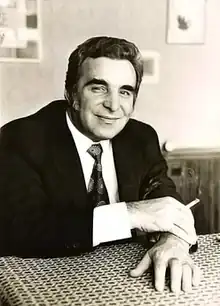Vadet Dalokay | |
|---|---|
 | |
| Mayor of Ankara | |
| In office 10 December 1973 – 12 December 1977 | |
| Preceded by | Ekrem Barlas |
| Succeeded by | Ali Dinçer |
| Personal details | |
| Born | Vedat Ali Dalokay 10 November 1927 Elazığ, Turkey |
| Died | 21 March 1991 (aged 63) Kırıkkale, Turkey |
| Political party | Republican People's Party Workers' Party Unity Party Socialist Workers' Party Party of the Socialist Revolution Populist Party Party of Social Democracy Social Democratic Populist Party People's Labour Party |
| Alma mater | Istanbul Technical University |
| Occupation | Architect |
Vedat Dalokay (10 November 1927 – 21 March 1991) was a renowned Kurdish architect and a former mayor of Ankara.
Early life and education
He was born in Elazığ in 1927 to İbrahim Bey from Pertek.[1] He was an Alevi Kurd.[2] He completed his elementary and secondary education in Elazığ. Then he left for Istanbul where he graduated from the faculty of architecture of Istanbul Technical University in 1949.[3] His lecturers there were Clemens Holzmeister and Paul Bonatz.[3] In 1950 he settled to Paris to begin post-graduate studies at the City Planning Department of the Sorbonne University in Paris, France, but then did not graduate.[3]
Career

Following his graduation in 1949, he entered the Ministry of Works and the Post and Telecommunications Department.[3]
In the 1973 Turkish local elections, he was elected as the mayor of Ankara from the Republican People's Party (CHP).[3] In 1975, Dalokay requested assistance from the Soviet Union to build a public transportation system and affordable housing in Ankara.[4] In 1977 Dalokay and other CHP mayors, including İstanbul mayor Ahmet İsvan and İzmit mayor Erol Köse issued a declaration on municipal socialism.[5]
Dalokay served as mayor of Ankara until the 1977 Turkish local elections and was replaced by another CHP member, Ali Dinçer in the post.
Awards and work
Along with numerous national award-winning projects in Turkey, Dalokay has been awarded internationally for the Islamic Development Bank (1981) in Riyadh, Saudi Arabia.
His design for the Kocatepe Mosque in the Turkish capital, Ankara was selected in the architectural competition in 1957 but, as a result of controversial criticism, was not built.[6] Later, a modified design was used as a basis for the Faisal Mosque in Islamabad, Pakistan.[3] In Pakistan, he was also the architect of two not realized buildings, then of the constricted monument Summit Minar, Lahore and is considered a major Turkish influence in Pakistani architecture.[3]
Death
Vedat Dalokay passed away with his wife Ayçe Dalokay (aged 64) in a traffic accident near Kırıkkale on 21 March 1991. His son Barış Dalokay (aged 17), who was injured in the accident, also died on 27 March 1991.
See also
References
- ↑ "Vedat Dalokay". Archived from the original on 18 December 2011. Retrieved 16 July 2011.
- ↑ "An Alevi Kurd built the famous mosque in Pakistan".
- 1 2 3 4 5 6 7 Naz, Neelum (2005). "Contribution of Turkish Architects to the National Architecture of Pakistan" (PDF). pp. 53–54.
- ↑ Hirst, Samuel J.; Khajei, Aydın; Kaptan, Deniz (2023). "A Turkish Mayor Goes to Moscow: Vedat Dalokay and Development Politics in the 1970s". Journal of Contemporary History. doi:10.1177/00220094231195768. ISSN 0022-0094.
- ↑ İpek Sakarya (Fall 2016). "Türkiye'de Toplumcu Belediyecilik Hareketi Ekseninde Çanakkale'de Yerel Siyaset (1968-1980)". Çanakkale Araştırmaları Türk Yıllığı (in Turkish). 14 (21): 139.
- ↑ "The Kocatepe Mosque Complex" (PDF). Diyanet. Archived from the original (PDF) on 28 May 2008.
Sources
- Drawings and model photos of Vedat Dalokay's unbuilt mosque design for the Kocatepe Mosque
- Animation of Vedat Dalokay's unbuilt mosque design for the Kocatepe Mosque
- As, Imdat "The Kocatepe Mosque Experience, " in Emergent Design: Rethinking Contemporary Mosque Architecture in Light of Digital Technology, S.M.Arch.S. Thesis, Massachusetts Institute of Technology, Cambridge, MA, 2002. pp.24-46
External links
- Vedat Dalokay in the German National Library catalogue
 Media related to Vedat Dalokay at Wikimedia Commons
Media related to Vedat Dalokay at Wikimedia Commons